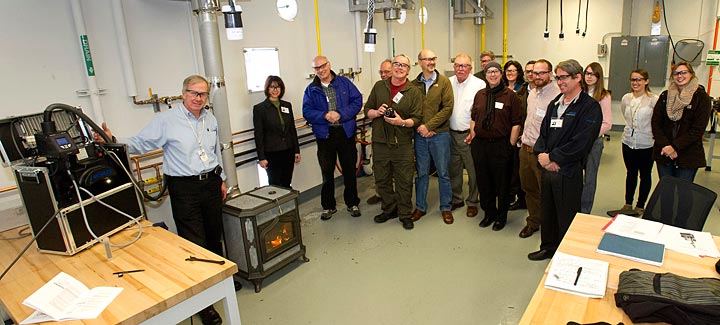Brookhaven Lab To Participate in Wood Stove Decathlon in Washington, D.C.
February 5, 2013

Tom Butcher, left, and members of the New York State Energy Research and Development Authority, the Environmental Protection Agency, key industry leaders and members of the Wood Stove Design Challenge team examine new emissions-testing equipment.
In January, Brookhaven Lab hosted a gathering of individuals who will serve as judges in a Wood Stove Decathlon, sponsored by the Alliance for Green Heat and scheduled to take place on the National Mall in Washington, D.C. in November, 2013. Eight members of the Wood Stove Design Challenge team met at the Lab over two days to review innovative designs and to examine new German wood appliance testing equipment that will likely be used to judge entries at the competition.
“Wood use for home heating is increasing and is becoming a major source of fine particle air pollution in the Northeast,” said Tom Butcher, head of the Energy Conversion Group in the Lab’s Sustainable Energy Technologies Department. “This event will highlight advanced technologies that can help address this problem and enable continued use of this renewable fuel.”
During the meeting, the Lab also hosted a webinar to review a new instrument, the Wohler SM 500 real-time particle emission rate analyzer, with members of the New York State Energy Research and Development Authority, the Environmental Protection Agency, and key industry leaders.
“Our new lab in the renovated D wing of Bldg. 815 provides a great platform for collaborative work like this study,” Butcher said.
The Design Challenge judges have different personal and institutional reasons for participating in the contest, but all agree that wood stoves need to operate cleaner and that design changes can make that happen.
“A key challenge in this competition is measuring wood stove particulate emissions accurately in a field environment,” Butcher said. “Brookhaven Lab will be comparing candidate methods against lab methods and implementing the measurements during the competition.”
A recent Challenge blogpost states that the competition “is pitting 16th century designs against microchip-controlled automation. And it is not clear who will win.”
More information on the Challenge is available.
2013-3628 | INT/EXT | Newsroom









